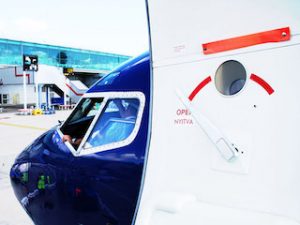Cost Savings Of Doing A Jet Orientation Course (JOC)
 In the aviation industry, pilots must navigate a structured and rigorous training pathway to qualify for commercial airline operations. One crucial component of this pathway is the Jet Orientation Course (JOC). This specialized course bridges the gap between basic flight training and the advanced type rating required for specific jet aircraft. While the primary focus of the JOC is to prepare pilots for the complexities of jet operations, it also offers significant cost-saving benefits. This article delves into the various ways in which completing a JOC can lead to substantial cost savings for pilots and airlines, enhancing the overall efficiency and affordability of pilot training.
In the aviation industry, pilots must navigate a structured and rigorous training pathway to qualify for commercial airline operations. One crucial component of this pathway is the Jet Orientation Course (JOC). This specialized course bridges the gap between basic flight training and the advanced type rating required for specific jet aircraft. While the primary focus of the JOC is to prepare pilots for the complexities of jet operations, it also offers significant cost-saving benefits. This article delves into the various ways in which completing a JOC can lead to substantial cost savings for pilots and airlines, enhancing the overall efficiency and affordability of pilot training.
Jet Orientation Course (JOC)
The Jet Orientation Course (JOC) is an advanced training program designed to equip pilots with the necessary skills and knowledge to transition from flying smaller, propeller-driven aircraft to jet-powered aircraft. The JOC covers essential topics such as high-speed aerodynamics, jet performance, flight control systems, and crew resource management (CRM). By providing a comprehensive understanding of these areas, the JOC prepares pilots for the demanding environment of commercial jet aviation.
Cost savings for pilots
Pilots investing in their training often face substantial financial commitments. The JOC, while an additional expense, can lead to considerable cost savings in the long run. Here’s how:
1) Reduced training time for type rating
One of the most significant cost-saving benefits of completing a JOC is the reduction in training time required for type rating certification. Type rating courses are specialized training programs that certify pilots to operate specific models of jet aircraft. These courses are both time-consuming and expensive.
-
- Preparedness: Pilots who have completed the JOC enter type rating training with a strong foundation in jet operations. This preparedness means they require less time to grasp the advanced concepts and procedures specific to the type rating course.
- Efficiency: With a solid understanding of jet aircraft systems and performance, pilots can progress through the type rating course more efficiently, reducing the number of flight hours and simulator sessions needed. This efficiency translates into lower training costs.
2) Improved pass rates
The comprehensive training provided by the JOC enhances pilots’ knowledge and skills, leading to improved pass rates in subsequent type rating courses and proficiency checks.
-
- Reduced retakes: Higher pass rates mean fewer retakes of exams and check rides, which can be costly. Each retake involves additional fees for training, examiner time, and aircraft or simulator usage.
- Confidence: The confidence gained from thorough preparation reduces the likelihood of failures, further minimising the need for costly retraining.
3) Career advancement opportunities
Completing the JOC enhances a pilot’s qualifications, making them more competitive in the job market. This competitive edge can lead to faster career progression and higher earning potential.
-
- Job opportunities: Airlines often prefer candidates who have completed the JOC, recognizing the value of the skills and knowledge gained through the course. This preference can lead to quicker job placements and a shorter period of unemployment.
- Higher salaries: Pilots with advanced training and certifications, such as the JOC, are often eligible for higher starting salaries. The increased earning potential can offset the initial investment in the course.
Cost savings for airlines
Airlines also benefit from the cost-saving advantages of hiring pilots who have completed the JOC. These savings contribute to overall operational efficiency and financial health.
1) Reduced training costs
Airlines invest significant resources in training their pilots. Hiring candidates who have completed the JOC can lead to substantial savings in training costs.
-
- Shorter training periods: As JOC-trained pilots are better prepared for type rating courses, the overall training period is shorter. This reduction in training time translates into lower costs for simulator sessions, instructor time, and training materials.
- Lower attrition rates: Pilots who have undergone the JOC are more likely to complete their training successfully and remain with the airline. Lower attrition rates mean fewer resources are spent on recruiting and training replacements.
2) Enhanced operational efficiency
The JOC’s emphasis on advanced skills and knowledge contributes to enhanced operational efficiency, which can result in significant cost savings for airlines.
-
- Fuel efficiency: Pilots trained through the JOC are well-versed in fuel management techniques and jet performance optimization. Improved fuel efficiency reduces operating costs, which is a significant expense for airlines.
- Reduced maintenance costs: Pilots with advanced training are better equipped to handle aircraft systems efficiently, leading to fewer operational errors and reduced wear and tear on the aircraft. This efficiency translates into lower maintenance costs.
3) Safety and Compliance
Safety and regulatory compliance are critical aspects of airline operations. The JOC’s comprehensive training ensures that pilots meet the highest standards of safety and proficiency, leading to cost savings in several areas.
-
- Insurance premiums: Airlines with a strong safety record and well-trained pilots can negotiate lower insurance premiums. The JOC contributes to this by ensuring pilots are well-prepared to handle emergencies and maintain operational safety.
- Regulatory compliance: Meeting regulatory requirements is essential for avoiding fines and penalties. The JOC ensures that pilots are well-versed in regulatory standards and best practices, reducing the risk of non-compliance.
Long-term financial benefits
The financial benefits of completing the JOC extend beyond immediate cost savings, offering long-term advantages for both pilots and airlines.
1) Sustainable career development
For pilots, investing in the JOC is an investment in their long-term career development. The skills and knowledge gained through the course provide a strong foundation for continuous professional growth and advancement.
-
- Advanced roles: Pilots with JOC training are well-positioned for advanced roles such as captain, instructor, or examiner. These roles typically come with higher salaries and additional benefits.
- Professional longevity: The JOC’s emphasis on advanced skills and knowledge ensures that pilots remain competitive and adaptable in the ever-evolving aviation industry. This adaptability enhances professional longevity and career stability.
2) Airline profitability
For airlines, the cost-saving benefits of hiring JOC-trained pilots contribute to overall profitability and financial health.
-
- Operational efficiency: Enhanced operational efficiency, reduced training costs, and lower attrition rates all contribute to improved profitability. Airlines can allocate resources more effectively, optimising their operations and bottom line.
- Competitive advantage: Airlines with highly trained pilots can offer better service, improved safety, and greater operational reliability. This competitive advantage can attract more passengers and increase market share, further enhancing profitability.
Conclusion
The Jet Orientation Course (JOC) is a crucial component of pilot training that offers significant cost-saving benefits for both pilots and airlines. By preparing pilots for the complexities of jet operations, the JOC reduces training time for type rating courses, improves pass rates, and enhances career prospects. For airlines, hiring JOC-trained pilots leads to reduced training costs, enhanced operational efficiency, and improved safety and compliance, all of which contribute to overall profitability.
Investing in the JOC is a strategic decision that pays off in the long run. Pilots gain a competitive edge in the job market, faster career progression, and higher earning potential. Airlines benefit from operational efficiency, lower training costs, and a strong safety record, all of which enhance financial health and market competitiveness.
As the aviation industry continues to evolve, the importance of the JOC will only grow. Both pilots and airlines must recognize the value of this specialised training program and leverage its cost-saving benefits to build a successful and sustainable future in aviation.










